
|
Demonstrations
| | D01 A Real Space Application by Visual Marker using Computer Displays |
| | |
Yasue Kishino, Masahiko Tsukamoto (Osaka University), Yutaka Sakane
(Shizuoka University), Shojiro Nishio (Osaka University)
|
|
| |
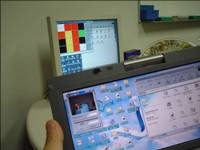 To construct augmented reality applications with a camera, it is
necessary to determine the concise location and the direction of the
camera, i.e., a user $B!G (Bs view, in which virtual objects are composed.
Recently, there have been extensive researches based on video analysis
to achieve this. In these approaches, paper-printed markers or LED
markers are typically placed in the real world, and users capture the
image of these markers to obtain their information. However, recent
trends in ubiquitous computing have required more dynamic and
interactive markers. In this research, we propose a new location marking
method, called VCC (Visual Computer Communication), which uses computer
displays to show markers and send information.
In our method, a marker in a matrix shape keeps blinking to provide both coordinate information and attached information such as an address or a
URL. We will demonstrate how a laptop PC with a CCD camera detect the
VCC marker, recognize the information, and overlay recognized
information or open a Web page pointed by the recognized URL. Since we
assume in the future environment there should be many ubiquitous
displays anywhere in the real world, our system can be used by users
walking around with their mobile computers equipped with cameras to
obtain various information and services.
To construct augmented reality applications with a camera, it is
necessary to determine the concise location and the direction of the
camera, i.e., a user $B!G (Bs view, in which virtual objects are composed.
Recently, there have been extensive researches based on video analysis
to achieve this. In these approaches, paper-printed markers or LED
markers are typically placed in the real world, and users capture the
image of these markers to obtain their information. However, recent
trends in ubiquitous computing have required more dynamic and
interactive markers. In this research, we propose a new location marking
method, called VCC (Visual Computer Communication), which uses computer
displays to show markers and send information.
In our method, a marker in a matrix shape keeps blinking to provide both coordinate information and attached information such as an address or a
URL. We will demonstrate how a laptop PC with a CCD camera detect the
VCC marker, recognize the information, and overlay recognized
information or open a Web page pointed by the recognized URL. Since we
assume in the future environment there should be many ubiquitous
displays anywhere in the real world, our system can be used by users
walking around with their mobile computers equipped with cameras to
obtain various information and services.
|
| | D02 The Uber-Badge |
| | |
Joe Paradiso (MIT Media Lab, USA)
|
|
| |
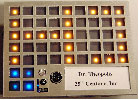 We present the design of a new badge platform for facilitating interaction in large groups of people. We have built this device to be very flexible in order to host a wide variety of interactions in the areas where wearable and social computing converge, from game environments to meetings and conventions. This badge has both RF and IR communication, a 5x9 LED display capable of presenting graphics and scrolling text that users in the vicinity can read, an onboard microphone for 12-bit audio sampling, a 12-bit audio output, a pager motor vibrator for vibratory feedback, 3 onboard processors, capacity for up to 256 MB of flash memory, provisions for connecting LCD displays, and connectors that mate into the Responsive Environments Group's Stack Sensor platform, allowing a variety of different sensors to be integrated. We describe several applications now being developed for this badge at the MIT Media Laboratory, and touch on how it was used in a multiplayer, augmented reality urban adventure hunt game in Manhattan in the summer of 2003.
We present the design of a new badge platform for facilitating interaction in large groups of people. We have built this device to be very flexible in order to host a wide variety of interactions in the areas where wearable and social computing converge, from game environments to meetings and conventions. This badge has both RF and IR communication, a 5x9 LED display capable of presenting graphics and scrolling text that users in the vicinity can read, an onboard microphone for 12-bit audio sampling, a 12-bit audio output, a pager motor vibrator for vibratory feedback, 3 onboard processors, capacity for up to 256 MB of flash memory, provisions for connecting LCD displays, and connectors that mate into the Responsive Environments Group's Stack Sensor platform, allowing a variety of different sensors to be integrated. We describe several applications now being developed for this badge at the MIT Media Laboratory, and touch on how it was used in a multiplayer, augmented reality urban adventure hunt game in Manhattan in the summer of 2003.
|
| | D03: ensemble: clothes, sensors and sound |
| | |
Kristina Andersen, STEIM, The Netherlands
|
|
| |
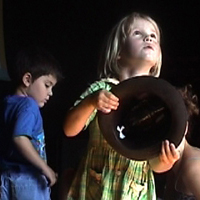 "ensemble" is a suitcase full of music making clothes designed for
children. Each piece of clothing uses sensors to modify a sound or
voice. The position of a hat, the swoosh of a dress, the darkness of a
ladies bag...
The project is developed as an exploration of using embedded wireless
sensors as tangible sonic objects and making them available to
pre-school children. By observing how they spontaneously explore and
interpret them, we aim at capturing their emerging understanding of the
causalities of electronic sensing.
Seven garments are fitted with wireless sensors that control sound
samples and their modifiers in real time. Each garment acts as carriers
both for the sensors and the wireless system. The sensors are separated
by type and placed in the garments in such a way that the function of
the sensor is conceptually supported by the form-factors of the garment.
The dress holds an accelerometer, the hat tilt switches etc. The
garments are using hacked and modified game-pads as wireless signal
carriers.
A number of ensemble garments will be demoed along with two pieces of
STEIM software: junXion and LiSa.
"ensemble" is a suitcase full of music making clothes designed for
children. Each piece of clothing uses sensors to modify a sound or
voice. The position of a hat, the swoosh of a dress, the darkness of a
ladies bag...
The project is developed as an exploration of using embedded wireless
sensors as tangible sonic objects and making them available to
pre-school children. By observing how they spontaneously explore and
interpret them, we aim at capturing their emerging understanding of the
causalities of electronic sensing.
Seven garments are fitted with wireless sensors that control sound
samples and their modifiers in real time. Each garment acts as carriers
both for the sensors and the wireless system. The sensors are separated
by type and placed in the garments in such a way that the function of
the sensor is conceptually supported by the form-factors of the garment.
The dress holds an accelerometer, the hat tilt switches etc. The
garments are using hacked and modified game-pads as wireless signal
carriers.
A number of ensemble garments will be demoed along with two pieces of
STEIM software: junXion and LiSa.
|
| | D04: Microservices: A Lightweight Web Service Infrastructure for Mobile Devices |
| | |
Nicholas Nicoloudis, School of Computer Science and Software Engineering, Monash University Australia
|
|
| |
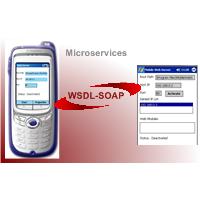 Our Microservices framework was developed to enable communication
amongst various web enabled mobile devices. The Microservices
framework facilitates peer-to-peer communication based
upon the architecture independent web services standard.
Interoperability is essential to enable communication
between mobile and assorted web enabled devices. Our framework
referred to as Microservices consists of two key areas;
the first includes a lightweight version of the web service
architecture. The second includes the development of a
compact and lightweight component-based web server capable
of supporting Microservices and a range of other internet
standards. In developing the web server we have taken
into consideration that the functionality supported and
resource requirements should not be as lightweight and
minimalist as existing embedded web servers. The reason
being is that mobile devices are at the centre of the
scale when it comes to hardware resource availability.
Several limitations are imposed in implementing the web
service framework for the mobile device. These limitations
are due to the constraints of available resources in comparison
to desktop systems. However, the framework remains compatible
with the original architecture, since it merely imposes
certain restrictions as opposed to a complete overhaul
of the underlying architecture.
Our Microservices framework was developed to enable communication
amongst various web enabled mobile devices. The Microservices
framework facilitates peer-to-peer communication based
upon the architecture independent web services standard.
Interoperability is essential to enable communication
between mobile and assorted web enabled devices. Our framework
referred to as Microservices consists of two key areas;
the first includes a lightweight version of the web service
architecture. The second includes the development of a
compact and lightweight component-based web server capable
of supporting Microservices and a range of other internet
standards. In developing the web server we have taken
into consideration that the functionality supported and
resource requirements should not be as lightweight and
minimalist as existing embedded web servers. The reason
being is that mobile devices are at the centre of the
scale when it comes to hardware resource availability.
Several limitations are imposed in implementing the web
service framework for the mobile device. These limitations
are due to the constraints of available resources in comparison
to desktop systems. However, the framework remains compatible
with the original architecture, since it merely imposes
certain restrictions as opposed to a complete overhaul
of the underlying architecture. |
| |
D05: Event-Triggered
SMS-Based Notification Services |
| |
|
Alois Ferscha (Johannes Kepler
University Linz, Austria) |
|
| |
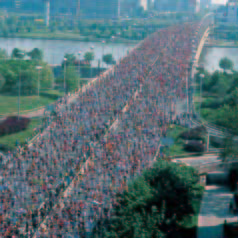 Short message services, initially designed for text communication
between two mobile phones, are nowadays used in many other
applications, including ordering of services and goods,
mobile payment, or delivery of news. We have designed,
implemented, and successfully deployed in real life an
SMS based notification system supporting push and pull
services for real time querying in sport events using
RFID for time keeping. Participants in the sport event,
e.g. runners or bikers, are equipped with RFID chips which
omit a unique ID to be captured by an RFID reader. Typically
such readers are positioned at the start and end of the
race, as well as on predefined control points for time
keeping. Most sport events offer internet based tools
to query race results. However, spectators of the event
would also be interested in querying and receiving intermediate
and final results in real time while watching the event,
where typically internet access cannot easily be provided.
This was our motivation for offering mobile SMS based
push and pull services. In the push service, users register
themselves for the race number of their choice giving
the mobile phone number where the results should be delivered.
If the race participant crosses the reader, the RFID signal
is captured and triggers not only the time keeping functions
but also queries a database for any registered delivery
requests. If requests are found, the time keeping data
are transferred into SMS format and delivered to the registered
number(s) via an SMS gateway provided by our partner ONE.
Compared to “traditional” internet based queries,
users benefit from the advantage of (nearly) world wide
coverage and from instant delivery of results triggered
by the event of interest itself. In the pull service,
the user would send an SMS with the contestants´
race number and would immediately receive the most current
results (e.g. half distance timings or at least the name
of the participant) available. The Vienna City Marathon
was the first sports event offering this notification
service. More than 10.000 messages have been delivered
via the push and the pull service to world wide destinations
at the day of the race.
Short message services, initially designed for text communication
between two mobile phones, are nowadays used in many other
applications, including ordering of services and goods,
mobile payment, or delivery of news. We have designed,
implemented, and successfully deployed in real life an
SMS based notification system supporting push and pull
services for real time querying in sport events using
RFID for time keeping. Participants in the sport event,
e.g. runners or bikers, are equipped with RFID chips which
omit a unique ID to be captured by an RFID reader. Typically
such readers are positioned at the start and end of the
race, as well as on predefined control points for time
keeping. Most sport events offer internet based tools
to query race results. However, spectators of the event
would also be interested in querying and receiving intermediate
and final results in real time while watching the event,
where typically internet access cannot easily be provided.
This was our motivation for offering mobile SMS based
push and pull services. In the push service, users register
themselves for the race number of their choice giving
the mobile phone number where the results should be delivered.
If the race participant crosses the reader, the RFID signal
is captured and triggers not only the time keeping functions
but also queries a database for any registered delivery
requests. If requests are found, the time keeping data
are transferred into SMS format and delivered to the registered
number(s) via an SMS gateway provided by our partner ONE.
Compared to “traditional” internet based queries,
users benefit from the advantage of (nearly) world wide
coverage and from instant delivery of results triggered
by the event of interest itself. In the pull service,
the user would send an SMS with the contestants´
race number and would immediately receive the most current
results (e.g. half distance timings or at least the name
of the participant) available. The Vienna City Marathon
was the first sports event offering this notification
service. More than 10.000 messages have been delivered
via the push and the pull service to world wide destinations
at the day of the race. |
| | D06: Visual Code Recognition for Camera-Equipped Mobile Phones |
| | |
Michael Rohs and Beat Gfeller,
Institute for Pervasive Computing,
Department of Computer Science,
Swiss Federal Institute of Technology (ETH) Zurich,
Switzerland
|
|
| |
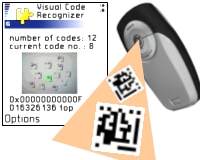 This demo illustrates how interaction with mobile phones can be enhanced
by using 2-dimensional visual codes. We present a visual code system for
camera-equipped mobile phones and a show number of example applications.
This demo illustrates how interaction with mobile phones can be enhanced
by using 2-dimensional visual codes. We present a visual code system for
camera-equipped mobile phones and a show number of example applications.
Even though the computing power of current mobile phones is limited and
the image quality of the cameras is comparatively poor, such devices can
act as mobile sensors for 2-dimensional visual codes. The codes we have
developed can be displayed on electronic screens, projected with a
beamer, printed on paper documents, or attached to physical objects.
They act as a key to access object-related information and
functionality.
The ability to detect objects in the user's vicinity offers a natural
way of interaction and strengthens the role of mobile phones in a large
number of application scenarios. Mobile phones are in constant reach of
their users, are thus available in everyday situations, and provide
continuous wireless connectivity. They are therefore suitable to act as
the user's "bridge" between physical entities in the real world and
associated entities in the virtual world.
The visual code system is designed for low-quality images and uses a
lightweight recognition algorithm. It allows the simultaneous detection
of multiple codes, introduces a position-independent code coordinate
system, and provides the phone's orientation as a parameter.
|
| | D07: Improving the Reality Perception of Visually Impaired |
| | |
Vlad Coroama, Institute for Pervasive Computing, ETH Zürich,
Felix Röthenbacher, Christoph Plüss, ETH Zürich
|
|
| |
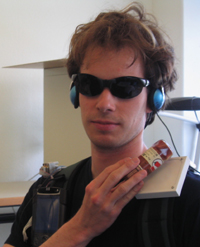 The visually impaired experience serious difficulties in leading an independent life. Particularly in unknown environments (foreign cities, large airport terminals) they rely on external assistance. But even ordinary tasks such as the daily shopping in the supermarket are hard to be performed independently. It is virtually impossible to distinguish between the thousands supermarket-products with other senses than the sight. The common cause for these problems is the lack of information the visually impaired have about their immediate surroundings.
The visually impaired experience serious difficulties in leading an independent life. Particularly in unknown environments (foreign cities, large airport terminals) they rely on external assistance. But even ordinary tasks such as the daily shopping in the supermarket are hard to be performed independently. It is virtually impossible to distinguish between the thousands supermarket-products with other senses than the sight. The common cause for these problems is the lack of information the visually impaired have about their immediate surroundings.
In this demo, we show the prototype of the Chatty Environment, a ubiquitous computing system designed to help the visually impaired to better understand their neighborhoods. The tagged objects in the chatty environment reveal their existence to the user through an audio interface, when he comes in their vicinity. The user can then interact with these entities, getting more information about their attributes or even perform small actions on them.
By supporting two complementary tagging methods, the system tries to map the way sighted people perceive the world. Large and important objects can be detected from a distance, as they advertise themselves to the user. For small supermarket-like items a different paradigm is used: the user has to explicitly pick up an object to begin interaction.
|
|

